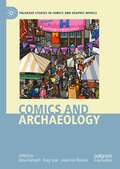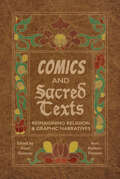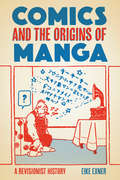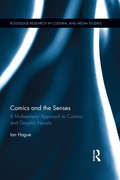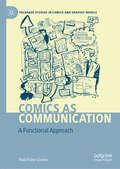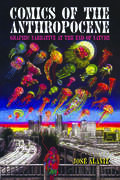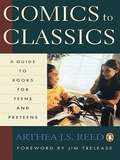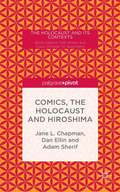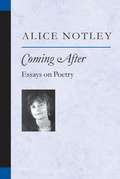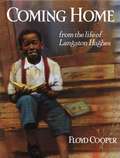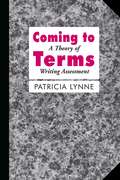- Table View
- List View
Comics and Adaptation
by Benoît Mitaine, David Roche and Isabelle Schmitt-PitiotContributions by Jan Baetens, Alain Boillat, Philippe Bourdier, Laura Cecilia Caraballo, Thomas Faye, Pierre Floquet, Jean-Paul Gabilliet, Christophe Gelly, Nicolas Labarre, Benoît Mitaine, David Roche, Isabelle Schmitt-Pitiot, Dick Tomasovic, and Shannon Wells-LassagneBoth comics studies and adaptation studies have grown separately over the past twenty years. Yet there are few in-depth studies of comic books and adaptations together. Available for the first time in English, this collection pores over the phenomenon of comic books and adaptation, sifting through comics as both sources and results of adaptation. Essays shed light on the many ways adaptation studies inform research on comic books and content adapted from them. Contributors concentrate on fidelity to the source materials, comparative analysis, forms of media, adaptation and myth, adaptation and intertextuality, as well as adaptation and ideology.After an introduction that assesses adaptation studies as a framework, the book examines comics adaptations of literary texts as more than just illustrations of their sources. Essayists then focus on adaptations of comics, often from a transmedia perspective. Case studies analyze both famous and lesser-known American, Belgian, French, Italian, and Spanish comics.Essays investigate specific works, such as Robert Louis Stevenson's The Strange Case of Dr. Jekyll and Mr. Hyde, the Castilian epic poem Poema de Mio Cid, Ray Bradbury's Martian Chronicles, French comics artist Jacques Tardi's adaptation 120, rue de la Gare, and Frank Miller's Sin City. In addition to Marvel Comics' blockbusters, topics include various uses of adaptation, comic book adaptations of literary texts, narrative deconstruction of performance and comic book art, and many more.
Comics and Archaeology (Palgrave Studies in Comics and Graphic Novels)
by Zena Kamash Katy Soar Leen Van BroeckThis book adds to the scant academic literature investigating how comics transmit knowledge of the past and how this refraction of the past shapes our understanding of society and politics in sometimes damaging ways. The volume comes at these questions from a specifically archaeological perspective, foregrounding the representation and narrative use of material cultures. It fulfils its objectives through three reception studies in the first part of the volume and three chapters by comic creators in the second part. All six chapters aim to grapple with a set of central questions about the power inherent in drawn images of various kinds.
Comics and Catharsis: Exploring Graphic Narratives of Trauma and Healing
by Jordan TronsgardContributions by Kelly Baron, Angie Chau, Jennifer Nagtegaal, Lee Okan, Diana Pifano, Russell Samolsky, Kay Sohini, Jordan Tronsgard, Anastasia Ulanowicz, and Aanchal Vij Comics and Catharsis: Exploring Graphic Narratives of Trauma and Healing explores the idea that trauma and healing hold an imbalance in many forms of literature—especially in the world of comics. Whether it be war-based, national, physical, or sexual trauma, this volume looks at a wide variety of trauma and the psychological pain and devastation that arise during and—crucially for the question of trauma narratives—following the events as the psychological (and often physical) wounds are processed.Essayists in the collection engage with questions of how comics process trauma through depictions and receptions. Viewing trauma through the lens of comics such as Maus, Persepolis, and Fun Home, as well as works by comics writers who are little known or unknown outside their communities, contributors analyze how trauma is used in artistic style, writing, and overall storytelling. Together, the essays in Comics and Catharsis show how people who have suffered trauma often flock to these works to find a way to acknowledge and process their own suffering.
Comics and Language: Reimagining Critical Discourse on the Form
by Hannah MiodragIt has become an axiom in comic studies that "comics is a language, not a genre." But what exactly does that mean, and how is discourse on the form both aided and hindered by thinking of it in linguistic terms? In Comics and Language, Hannah Miodrag challenges many of the key assumptions about the "grammar" and formal characteristics of comics, and offers a more nuanced, theoretical framework that she argues will better serve the field by offering a consistent means for communicating critical theory in the scholarship. Through engaging close readings and an accessible use of theory, this book exposes the problems embedded in the ways critics have used ideas of language, literature, structuralism, and semiotics, and sets out a new and more theoretically sound way of understanding how comics communicate. Comics and Language argues against the critical tendency to flatten the distinctions between language and images and to discuss literature purely in terms of story content. It closely examines the original critical theories that such arguments purport to draw on and shows how they in fact point away from the conclusions they are commonly used to prove. The book improves the use the field makes of existing scholarly disciplines and furthers the ongoing sophistication of the field. It provides animated and insightful analyses of a range of different texts and takes an interdisciplinary approach. Comics and Language will appeal to the general comics reader and will prove crucial for specialized scholars in the fields of comics, literature, cultural studies, art history, and visual studies. It also provides a valuable summary of the current state of formalist criticism within comics studies and so presents the ideal text for those interested in exploring this growing area of research
Comics and Modernism: History, Form, and Culture (Tom Inge Series on Comics Artists)
by Jonathan NajarianContributions by David M. Ball, Scott Bukatman, Hillary Chute, Jean Lee Cole, Louise Kane, Matthew Levay, Andrei Molotiu, Jonathan Najarian, Katherine Roeder, Noa Saunders, Clémence Sfadj, Nick Sturm, Glenn Willmott, and Daniel Worden Since the early 1990s, cartoonist Art Spiegelman has made the case that comics are the natural inheritor of the aesthetic tradition associated with the modernist movement of the early twentieth century. In recent years, scholars have begun to place greater import on the shared historical circumstances of early comics and literary and artistic modernism. Comics and Modernism: History, Form, and Culture is an interdisciplinary consideration of myriad social, cultural, and aesthetic connections. Filling a gap in current scholarship, an impressively diverse group of scholars approaches the topic from a variety of disciplinary backgrounds and methodologies. Drawing on work in literary studies, art history, film studies, philosophy, and material culture studies, contributors attend to the dynamic relationship between avant-garde art, literature, and comics. Essays by both established and emerging voices examine topics as divergent as early twentieth-century film, museum exhibitions, newspaper journalism, magazine illustration, and transnational literary circulation. In presenting varied critical approaches, this book highlights important interpretive questions for the field. Contributors sometimes arrive at thoughtful consensus and at other times settle on productive disagreements. Ultimately, this collection aims to extend traditional lines of inquiry in both comics studies and modernist studies and to reveal overlaps between ostensibly disparate artistic practices and movements.
Comics and Narration
by Thierry GroensteenThis book is the follow-up to Thierry Groensteen's groundbreaking The System of Comics, in which the leading French-language comics theorist set out to investigate how the medium functions, introducing the principle of iconic solidarity, and showing the systems that underlie the articulation between panels at three levels: page layout, linear sequence, and nonsequential links woven through the comic book as a whole. He now develops that analysis further, using examples from a very wide range of comics, including the work of American artists such as Chris Ware and Robert Crumb. He tests out his theoretical framework by bringing it up against cases that challenge it, such as abstract comics, digital comics and shojo manga, and offers insightful reflections on these innovations. In addition, he includes lengthy chapters on three areas not covered in the first book. First, he explores the role of the narrator, both verbal and visual, and the particular issues that arise out of narration in autobiographical comics. Second, Groensteen tackles the question of rhythm in comics, and the skill demonstrated by virtuoso artists in intertwining different rhythms over and above the basic beat provided by the discontinuity of the panels. And third he resets the relationship of comics to contemporary art, conditioned by cultural history and aesthetic traditions but evolving recently as comics artists move onto avant-garde terrain.
Comics and Novelization: A Literary History of Bandes Dessinées (Routledge Interdisciplinary Perspectives on Literature)
by Benoît GlaudeThis book opens a novel perspective on comics and literature interactions. It claims that the two artistic media have always maintained a mutual emulation, for as long as they have coexisted in media culture. To demonstrate this, the present research does not focus on literary adaptations in comics form but rather on a literary corpus that remains virtually unexplored: comics-related novels. The purpose of this volume is to inventory French comics-related novels and to study them. Within the limits of the French-speaking world, this book pieces together a literary history of bande dessinée through its novels, from the nineteenth to twenty-first centuries. Although the comic strip – including the aptly named "graphic novel" – has sometimes been regarded as the disciple of an unsurpassable literary model, do these under-studied adaptations in novel form not rather indicate a mutual relationship, or even an emulation, between the two media?
Comics and Sacred Texts: Reimagining Religion and Graphic Narratives
by Assaf Gamzou and Ken Koltun-FrommContributions by Ofra Amihay, Madeline Backus, Samantha Baskind, Elizabeth Rae Coody, Scott S. Elliott, Assaf Gamzou, Susan Handelman, Leah Hochman, Leonard V. Kaplan, Ken Koltun-Fromm, Shiamin Kwa, Samantha Langsdale, A. David Lewis, Karline McLain, Ranen Omer-Sherman, Joshua Plencner, and Jeffrey L. RicheyComics and Sacred Texts explores how comics and notions of the sacred interweave new modes of seeing and understanding the sacral. Comics and graphic narratives help readers see religion in the everyday and in depictions of God, in transfigured, heroic selves as much as in the lives of saints and the meters of holy languages. Coeditors Assaf Gamzou and Ken Koltun-Fromm reveal the graphic character of sacred narratives, imagining new vistas for both comics and religious texts. In both visual and linguistic forms, graphic narratives reveal representational strategies to encounter the sacred in all its ambivalence. Through close readings and critical inquiry, these essays contemplate the intersections between religion and comics in ways that critically expand our ability to think about religious landscapes, rhetorical practices, pictorial representation, and the everyday experiences of the uncanny. Organized into four sections—Seeing the Sacred in Comics; Reimagining Sacred Texts through Comics; Transfigured Comic Selves, Monsters, and the Body; and The Everyday Sacred in Comics—the essays explore comics and graphic novels ranging from Craig Thompson’s Habibi and Marvel’s X-Men and Captain America to graphic adaptions of religious texts such as 1 Samuel and the Gospel of Mark.Comics and Sacred Texts shows how claims to the sacred are nourished and concealed in comic narratives. Covering many religions, not only Christianity and Judaism, this rare volume contests the profane/sacred divide and establishes the import of comics and graphic narratives in disclosing the presence of the sacred in everyday human experience.
Comics and Stuff
by Henry JenkinsConsiders how comics display our everyday stuff—junk drawers, bookshelves, attics—as a way into understanding how we represent ourselves nowFor most of their history, comics were widely understood as disposable—you read them and discarded them, and the pulp paper they were printed on decomposed over time. Today, comic books have been rebranded as graphic novels—clothbound high-gloss volumes that can be purchased in bookstores, checked out of libraries, and displayed proudly on bookshelves. They are reviewed by serious critics and studied in university classrooms. A medium once considered trash has been transformed into a respectable, if not elite, genre.While the American comics of the past were about hyperbolic battles between good and evil, most of today’s graphic novels focus on everyday personal experiences. Contemporary culture is awash with stuff. They give vivid expression to a culture preoccupied with the processes of circulation and appraisal, accumulation and possession. By design, comics encourage the reader to scan the landscape, to pay attention to the physical objects that fill our lives and constitute our familiar surroundings. Because comics take place in a completely fabricated world, everything is there intentionally. Comics are stuff; comics tell stories about stuff; and they display stuff.When we use the phrase “and stuff” in everyday speech, we often mean something vague, something like “etcetera.” In this book, stuff refers not only to physical objects, but also to the emotions, sentimental attachments, and nostalgic longings that we express—or hold at bay—through our relationships with stuff.In Comics and Stuff, his first solo authored book in over a decade, pioneering media scholar Henry Jenkins moves through anthropology, material culture, literary criticism, and art history to resituate comics in the cultural landscape. Through over one hundred full-color illustrations, using close readings of contemporary graphic novels, Jenkins explores how comics depict stuff and exposes the central role that stuff plays in how we curate our identities, sustain memory, and make meaning. Comics and Stuff presents an innovative new way of thinking about comics and graphic novels that will change how we think about our stuff and ourselves.
Comics and the Origins of Manga: A Revisionist History
by Eike ExnerComics and the Origins of Manga challenges the conventional wisdom that manga evolved from traditional Japanese art, and reveals how Japanese cartoonists in the 1920s and 1930s instead developed modern manga out of translations of foreign comic strips like Bringing Up Father, Happy Hooligan, and Felix the Cat.
Comics and the Senses: A Multisensory Approach to Comics and Graphic Novels (Routledge Research in Cultural and Media Studies)
by Ian HagueAttempts to define what comics are and explain how they work have not always been successful because they are premised upon the idea that comic strips, comic books and graphic novels are inherently and almost exclusively visual. This book challenges that premise, and asserts that comics is not just a visual medium. The book outlines the multisensory aspects of comics: the visual, audible, tactile, olfactory and gustatory elements of the medium. It rejects a synaesthetic approach (by which all the senses are engaged through visual stimuli) and instead argues for a truly multisensory model by which the direct stimulation of the reader’s physical senses can be understood. A wide range of examples demonstrates how multisensory communication systems work in both commercial and more experimental contexts. The book concludes with a case study that looks at the works of Alan Moore and indicates areas of interest that multisensory analysis can draw out, but which are overlooked by more conventional approaches.
Comics and the U.S. South
by Brannon CostelloComics and the U.S. South offers a wide-ranging and long overdue assessment of how life and culture in the United States South is represented in serial comics, graphic novels, newspaper comic strips, and webcomics. Diverting the lens of comics studies from the skyscrapers of Superman's Metropolis or Chris Ware's Chicago to the swamps, backroads, small towns, and cities of the U.S. South, this collection critically examines the pulp genres associated with mainstream comic books alongside independent and alternative comics.Some essays seek to discover what Captain America can reveal about southern regionalism and how slave narratives can help us reread Swamp Thing; others examine how creators such as Walt Kelly (Pogo), Howard Cruse (Stuck Rubber Baby), Kyle Baker (Nat Turner), and Josh Neufeld (A.D.: New Orleans after the Deluge) draw upon the unique formal properties of the comics to question and revise familiar narratives of race, class, and sexuality; and another considers how southern writer Randall Kenan adapted elements of comics form to prose fiction. With essays from an interdisciplinary group of scholars, Comics and the U.S. South contributes to and also productively reorients the most significant and compelling conversations in both comics scholarship and in southern studies.
Comics as Communication: A Functional Approach (Palgrave Studies in Comics and Graphic Novels)
by Paul Fisher DaviesThis book explores how comics function to make meanings in the manner of a language. It outlines a framework for describing the resources and practices of comics creation and readership, using an approach that is compatible with similar descriptions of linguistic and multimodal communication. The approach is based largely on the work of Michael Halliday, drawing also on the pragmatics of Paul Grice, the Text World Theory of Paul Werth and Joanna Gavins, and ideas from art theory, psychology and narratology. This brings a broad Hallidayan framework of multimodal analysis to comics scholarship, and plays a part in extending that tradition of multimodal linguistics to graphic narrative.
Comics in Translation
by Federico ZanettinComics are a pervasive art form and an intrinsic part of the cultural fabric of most countries. And yet, relatively little has been written on the translation of comics. Comics in Translation attempts to address this gap in the literature and to offer the first and most comprehensive account of various aspects of a diverse range of social practices subsumed under the label 'comics'. Focusing on the role played by translation in shaping graphic narratives that appear in various formats, different contributors examine various aspects of this popular phenomenon. Topics covered include the impact of globalization and localization processes on the ways in which translated comics are embedded in cultures; the import of editorial and publishing practices; textual strategies adopted in translating comics, including the translation of culture- and language-specific features; and the interplay between visual and verbal messages. Comics in translation examines comics that originate in different cultures, belong to quite different genres, and are aimed at readers of different age groups and cultural backgrounds, from Disney comics to Art Spiegelman's Maus, from Katsuhiro Ōtomo's Akira to Goscinny and Uderzo's Astérix. The contributions are based on first-hand research and exemplify a wide range of approaches. Languages covered include English, Italian, Spanish, Arabic, French, German, Japanese and Inuit. The volume features illustrations from the works discussed and an extensive annotated bibliography. Contributors include: Raffaella Baccolini, Nadine Celotti, Adele D'Arcangelo, Catherine Delesse, Elena Di Giovanni, Heike Elisabeth Jüngst, Valerio Rota, Carmen Valero-Garcés, Federico Zanettin and Jehan Zitawi.
Comics of the Anthropocene: Graphic Narrative at the End of Nature
by José AlanizSince the first Earth Day in 1970, how have US comics artists depicted the human-caused destruction of the natural world? How do these representations manifest in different genres of comics like superheroes, biography, underground comix, and journalism? What resources unique to the comics medium do they bring to their tasks? How do these works resonate with the ethical and environmental issues raised by global conversations about the anthropogenic sixth mass extinction and climate change? How have comics mourned the loss of nature over the last five decades? Are comics “ecological objects,” in philosopher Timothy Morton’s parlance? Weaving together insights from comics studies, environmental humanities, critical animal studies, and affect studies to answer these questions, Comics of the Anthropocene: Graphic Narrative at the End of Nature explores the representation of animals, pollution, mass extinctions, and climate change in the Anthropocene Era, our current geological age of human-induced environmental transformation around the globe. Artists and works examined in Comics of the Anthropocene include R. Crumb, Don McGregor et al.’s Black Panther, Jack Kirby’s Kamandi: The Last Boy on Earth, the comics of the Pacific Northwest, and Stephen Murphy and Michael Zulli’s landmark alternative series The Puma Blues. This book breaks new ground in confronting our most daunting modern crisis through a discussion of how graphic narrative has uniquely addressed the ecology issue.
Comics to Classics: A Guide to Books for Teens and Preteens
by Jim Trelease Arthea J. ReedFor each developmental stage between the ages of 10 and 18, educator Arthea Reed provides lists of books all carefully selected and organized for teen appeal. This guide will help parents and older children choose the right books for every reading level and interest.
Comics, Trauma, and the New Art of War
by Harriet E. EarleConflict and trauma remain among the most prevalent themes in film and literature. Comics has never avoided such narratives, and comics artists are writing them in ways that are both different from and complementary to literature and film. In Comics, Trauma, and the New Art of War, Harriet E. H. Earle brings together two distinct areas of research--trauma studies and comics studies--to provide a new interpretation of a long-standing theme. Focusing on representations of conflict in American comics after the Vietnam War, Earle claims that the comics form is uniquely able to show traumatic experience by representing events as viscerally as possible.Using texts from across the form and placing mainstream superhero comics alongside alternative and art comics, Earle suggests that comics are the ideal artistic representation of trauma. Because comics bridge the gap between the visual and the written, they represent such complicated narratives as loss and trauma in unique ways, particularly through the manipulation of time and experience. Comics can fold time and confront traumatic events, be they personal or shared, through a myriad of both literary and visual devices. As a result, comics can represent trauma in ways that are unavailable to other narrative and artistic forms.With themes such as dreams and mourning, Earle concentrates on trauma in American comics after the Vietnam War. Examples include Alissa Torres's American Widow, Doug Murray's The 'Nam, and Art Spiegelman's much-lauded Maus. These works pair with ideas from a wide range of thinkers, including Sigmund Freud, Mikhail Bakhtin, and Fredric Jameson, as well as contemporary trauma theory and clinical psychology. Through these examples and others, Comics, Trauma, and the New Art of War proves that comics open up new avenues to explore personal and public trauma in extraordinary, necessary ways.
Comics, the Holocaust and Hiroshima
by Jane L. Chapman Dan Ellin Adam SherifComics and the Holocaust breaks new ground for cultural history by exploring the relationship between comics as a cultural record, historiography, memory and trauma studies. Comics have a dual role as sources: for gauging awareness of the Holocaust and through close analysis, as testimonies and narratives of childhood emotions and experiences.
Comics: An Introduction
by Harriet E.H. EarleComics: An Introduction provides a clear and detailed introduction to the Comics form – including graphic narratives and a range of other genres – explaining key terms, history, theories, and major themes. The book uses a variety of examples to show the rich history as well as the current cultural relevance and significance of Comics. Taking a broadly global approach, Harriet Earle discusses the history and development of the form internationally, as well as how to navigate comics as a new way of reading. Earle also pushes beyond the book to lay out the ways that fans engage with their comics of choice – and how this can impact the industry. She also analyses how Comics can work for social change and political comment. Discussing journalism and life writing, she examines how the coming together of word and image gives us new ways to discuss our world and ourselves. A glossary and further reading section help those new to Comics solidify their understanding and further their exploration of this dynamic and growing field.
Coming
by Jean-Luc NancyComing is a lyrical, erudite examination of the French notion of jouissance. How did jouissance evolve from referring to the pleasure of possessing a material thing (property, wealth) to the pleasure of orgasm, from appropriation to dis-appropriation, from consumption to consummation? The philosophers Adèle van Reeth and Jean-Luc Nancy engage in a lively dialogue, ranging from consumerism to video games to mysticism and from Spinoza, Hegel, andAugustine to the Marquis de Sade, Marguerite Duras, and Henry Miller. Four additional essays are new to the American edition.
Coming After: Essays on Poetry
by Alice NotleyComing After gathers critical pieces by acclaimed poet Alice Notley, author of Mysteries of Small Houses and Disobedience. Notley explores the work of second-generation New York School poets and their allies: Ted Berrigan, Anne Waldman, Joanne Kyger, Ron Padgett, Lorenzo Thomas, and others. These essays and reviews are among the first to deal with a generation of poets notorious for their refusal to criticize and theorize, assuming the stance that "only the poems matter." The essays are characterized by Notley's strong, compelling voice, which transfixes the reader even in the midst of professional detail. Coming After revives the possibility of the readable book of criticism.
Coming Home: From The Life Of Langston Hughes
by Floyd CooperYoung Langston Hughes was a dreamer. He dreamed about heroes like Booker T. Washington, who was black just like him. When he heard the clackety-clack of train wheels, he dreamed about the places it had been. <P><P>But most of all, he dreamed about having a happy home. And so, one day, he began turning those dreams into beautiful prose. As he did, he discovered where his home really was—in the words and rhythms of his poetry that reached people all over the world. <p><p>The beloved Langston Hughes comes to life in a book for poets, dreamers, children and adults; anyone who has ever thought of what home means to them.
Coming Through the Fire: Surviving Race and Place in America
by C. Eric LincolnIn Coming through the Fire, prominent scholar and writer C. Eric Lincoln addresses the most important issue of our time with insights forged by a lifetime of confronting racial oppression in America. Born in a small rural town in northern Alabama, raised by his grandparents, Lincoln portrays in rich detail the nuances of racial conflict and control that characterized the community of Athens, personal experiences which would lead him to dedicate his life to illuminating issues of race and social identity. The contradictions and calamities of being black and poor in the United States become a purifying fire for his searing analyses of the contemporary meanings of race and color. Coming through the Fire, with its fiercely intelligent, passionate, and clear-eyed view of race and class conflict, makes a major contribution to understanding-and thereby healing-the terrible rift that has opened up in the heart of America. Lincoln explores the nature of biracial relationships, the issue of transracial adoption, violence-particularly black-on-black violence-the "endangered" black male, racism as power, the relationship between Blacks and Jews, our multicultural melting pot, and Minister Louis Farrakhan. Without sidestepping painful issues, or sacrificing a righteous anger, the author argues for "no-fault reconciliation," for mutual recognition of the human endowment we share regardless of race, preparing us as a nation for the true multiculture tomorrow will demand. Readers familiar with Lincoln's earlier groundbreaking work on the Black Muslims and on the black church will be eagerly awaiting the publication of Coming through the Fire. Others will simply find C. Eric Lincoln's personal story and his exploration of survival and race in America to be absorbing and compelling reading.
Coming To Terms: A Theory of Writing Assessment
by Patricia LynneIn a provocative book-length essay, Patricia Lynne argues that most programmatic assessment of student writing in U.S. public and higher education is conceived in the terms of mid-20th century positivism. Since composition as a field had found its most compatible home in constructivism, she asks, why do compositionists import a conceptual frame for assessment that is incompatible with composition theory? By casting this as a clash of paradigms, Lynne is able to highlight the ways in which each theory can and cannot influence the shape of assessment within composition. She laments, as do many in composition, that the objectively oriented paradigm of educational assessment theory subjugates and discounts the very social constructionist principles that empower composition pedagogy. Further, Lynne criticizes recent practice for accommodating the big business of educational testing—especially for capitulating to the discourse of positivism embedded in terms like "validity" and "reliability." These terms and concepts, she argues, have little theoretical significance within composition studies, and their technical and philosophical import are downplayed by composition assessment scholars. There is a need, Lynne says, for terms of assessment that are native to composition. To open this needed discussion within the field, she analyzes cutting-edge assessment efforts, including the work of Broad and Haswell, and she advances a set of alternate terms for evaluating assessment practices, a set of terms grounded in constructivism and composition. Coming to Terms is ambitious and principled, and it takes a controversial stand on important issues. This strong new volume in assessment theory will be of serious interest to assessment specialists and their students, to composition theorists, and to those now mounting assessments in their own programs.
Coming To: Consciousness and Natality in Early Modern England
by Timothy M. HarrisonIn Coming To, Timothy M. Harrison uncovers the forgotten role of poetry in the history of the idea of consciousness. Drawing our attention to a sea change in the English seventeenth century, when, over the course of a half century, “conscience” made a sudden shift to “consciousness,” he traces a line that leads from the philosophy of René Descartes to the poetry of John Milton, from the prenatal memories of theologian Thomas Traherne to the unresolved perspective on natality, consciousness, and ethics in the philosophy of John Locke. Each of these figures responded to the first-person perspective by turning to the origins of how human thought began. Taken together, as Harrison shows, this unlikely group of thinkers sheds new light on the emergence of the concept of consciousness and the significance of human natality to central questions in the fields of literature, philosophy, and the history of science.

